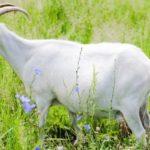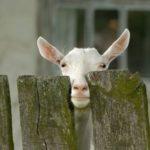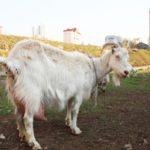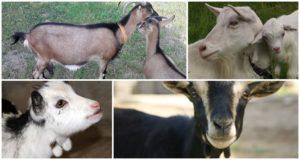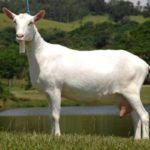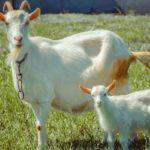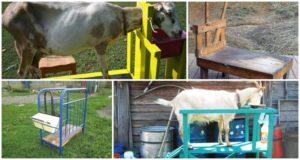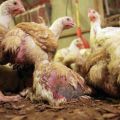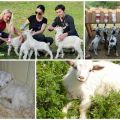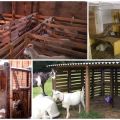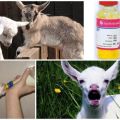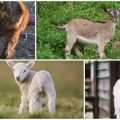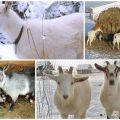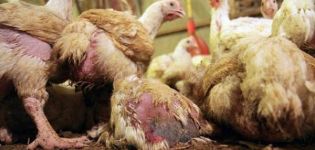Causes and symptoms of coccidiosis in sheep and goats, diagnosis and treatment
Coccidiosis (eimeriosis) is an infectious disease that affects mammals and humans, caused by primitive microorganisms of the Coccidia order, the Aymeria family. The infection invades the epithelial lining of the intestines, kidneys, liver, and other soft internal organs, causing severe emaciation and reduced productivity in small ruminants. In the absence of treatment for coccidiosis in goats, there is a massive death of the livestock.
Causes of coccidiosis in kids
Favorable conditions for active reproduction of pathogenic microorganisms are high humidity and coolness. Infection of goats and sheep occurs mainly when grazing on a damp pasture located in a lowland, in a floodplain or swampy area. The risk of an outbreak of coccidiosis increases when goats are kept in damp and dark conditions, when animals pick up food from a damp and dirty floor, when they use water from a stagnant reservoir for drinking.
The susceptibility of goats to coccidiosis increases with a decrease in immunity due to stress, poor nutrition, castration, and transportation. Disease outbreaks are more frequent on rainy and chilly summer days, and during the spring transition from stables to grazing on pastures. Basement rodents, dipterans, and birds can spread coccidia.
Kids and lambs are infected from mothers, in which pathogenic microorganisms multiply on the udder. More than 12 types of coccidia become the causative agents of coccidiosis in goats. Mixed infection prevails, when the animal's body is attacked by several types of microbes at once, but Eimeria faurei and Eimeria arloigni are most often detected in goats.
The animal accidentally ingests the parasite's oocysts. In the intestine, oocysts release sporozoites, which attach to the epithelial intestinal integument or, once in the vascular bed, are carried with the blood throughout the body, deposited in the tissues of the liver, kidneys, and other soft organs. There, by asexual division, they pass into a mobile form of existence - merozoites.

Destroying epithelial tissues, merozoites divide many times. Then gametogony occurs - the formation of female and male cells. The reproductive cells fuse to form oocysts. With the feces, oocysts leave the intestines of the host to become the causative agent of the disease.
Symptoms of the disease
The incubation stage lasts at least a week, at most a month. There is an acute, subacute and chronic course of the disease.Coccidia affect the epithelial integument along the entire length of the small intestine. In the foci of parasitic lesions, inflammation occurs, leading to severe tissue degeneration.
In sick goats, the concentration of hemoglobin decreases, the number of normoblasts increases, basophilic puncture of red blood cells increases, hypochromic anemia develops, erythrocytes change shape and size - signs of body poisoning with decay products. The functioning of the circulatory system, the digestive tract is disrupted.
In adult goats and sheep, a 23-25% lag in weight gain is revealed, in lambs - by 15%, in kids - by 45-47%. Milk yield is reduced by 35%. In its acute form, coccidiosis occurs in kids and lambs for up to a year. Symptoms are pronounced, mortality is 10-25%, the sick animal dies after 2-10 days from infection.
Symptoms of acute coccidiosis:
- emaciation, anemia, blanching of the mucous membranes;
- exhaustion, impotence, inability to stay on your feet;
- diarrhea, disruption of the digestive system, refusal to eat;
- body temperature 40-41 ° C;
- mucous and blood inclusions in feces;
- cramps of the neck and thigh muscles;
- conjunctivitis, rhinitis;
- reduction of red blood cells to 5 million in 1 mm3;
- drop in hemoglobin concentration to 35%.
Acute coccidiosis can become subacute or chronic. A chronic course with blurred symptoms occurs in goats up to 2 years of age. 40-70% of infected individuals die.
Symptoms of the chronic form:
- anemia, thinness;
- short-term temperature rise up to 40 ° C;
- diarrhea with mucus and bloody spots;
- on the 8-10th day after infection, the appearance of small gray warts on the face and ears (not all goats).

Diagnostic rules
A veterinarian diagnoses coccidiosis using a set of methods. When making a diagnosis, the result of a laboratory study of feces of goats, analysis of scraped tissues of internal organs is taken into account. Symptoms of coccidiosis in goats are similar to those of pasteurellosis, paratyphoid fever, enterocolitis, but coccidia oocysts found in feces accurately indicate the disease.
Scraping of intestinal tissue is done from dead goats. In an animal that has died from coccidiosis:
- extreme exhaustion;
- the area of the anus is stained with liquid feces;
- the mucous membranes of the small intestine are inflamed over the entire surface;
- in some areas of the internal intestinal walls, blood nodules and veins are noticeable, gray or gray-yellow balls the size of a millet grain are enlarged intestinal villi, coccidia actively multiply in them.
Treatment methods
Infected animals are isolated. For therapy use:
- ichthyol solution;
- "Akrikhin" + "Plazmotsid";
- "Phenothiazine";
- Albargin;
- "Norsulfazole";
- "Hexachloran".
Treatment is carried out with any of the listed drugs or a complex, according to a strictly established scheme. To accelerate the recovery of goats, it is recommended to increase the portion of concentrates in the diet, and use vitamin supplements. Ichthyol 15% aqueous solution is given to kids and lambs 2-5 months of age, 60-80 ml once a day for 3 days. Then a 3-day pause is made, after which two more similar courses of admission follow.
Akrikhin is given for 5 days, followed by a weekly pause, after which the course is repeated. On the 1st day of each course, the daily dose is 4 tablets per 0.5 l of water 2 times a day. On the 2nd-4th day - 2 tablets 2 times a day. For the course, one 3-month-old kid takes 48 tablets. The reception of the complex "Akrihin" + "Plasmotsid" is similar. The tablets dissolved in 50 ml of water are given orally to the kids. The course requires 48 tablets (Akrihin - 4.8 g, Plazmotsid - 1 g).

"Norsulfazole" is given at 5 mg per 1 kg of body weight 3 times a day for 3 days. After a 3-day pause, the therapy is repeated 2 more times."Hexachloran" powder 10% is given to 2-3-month-old kids at 200 mg per 1 kg of body weight for 3 days.
The complex "Ichthyol" + "Phenothiazine" + "Albargin" is used to treat one-year-old goats. On the 1st day, an ichthyol solution is shown (4 g of substance per 150 ml of water), on the 2nd - "Albargin" (3 g), on the 3rd - "Phenothiazine" (10 g).
Prevention of coccidiosis
To reduce the likelihood of infection of goats with coccidiosis, the following preventive measures are observed:
- They do not graze livestock in lowlands, wetlands.
- Do not allow animals to drink from a puddle, swamp, overgrown pond.
- They practice paddock grazing, change plots every 10 days.
- A smooth transition from winter to spring maintenance is carried out.
- The feed is placed in the troughs rather than sprinkled on the floor.
- Keeping the barn clean. Manure is collected in a timely manner and sent to the storage.
Recovered goats do not develop immunity to coccidiosis, animals remain carriers of infection for a long time, and are able to infect neighbors in the stable. These goats are kept isolated and more thoroughly disinfected.
